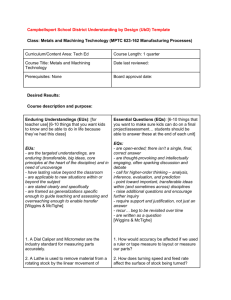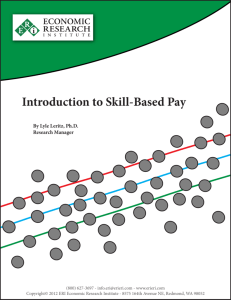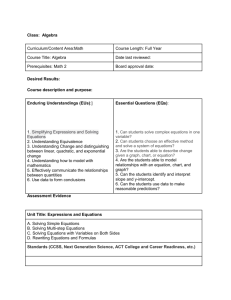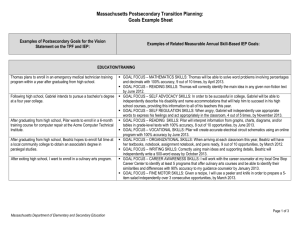The Why and How of Skill-Based Pay
advertisement
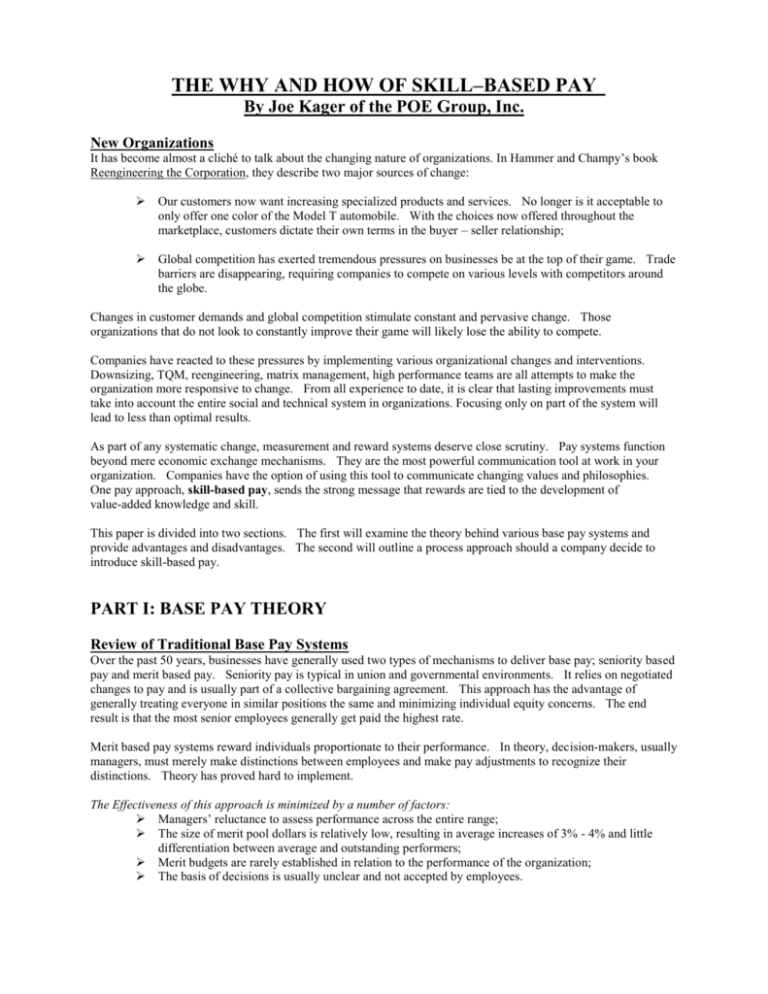
THE WHY AND HOW OF SKILL–BASED PAY By Joe Kager of the POE Group, Inc. New Organizations It has become almost a cliché to talk about the changing nature of organizations. In Hammer and Champy’s book Reengineering the Corporation, they describe two major sources of change: Our customers now want increasing specialized products and services. No longer is it acceptable to only offer one color of the Model T automobile. With the choices now offered throughout the marketplace, customers dictate their own terms in the buyer – seller relationship; Global competition has exerted tremendous pressures on businesses be at the top of their game. Trade barriers are disappearing, requiring companies to compete on various levels with competitors around the globe. Changes in customer demands and global competition stimulate constant and pervasive change. Those organizations that do not look to constantly improve their game will likely lose the ability to compete. Companies have reacted to these pressures by implementing various organizational changes and interventions. Downsizing, TQM, reengineering, matrix management, high performance teams are all attempts to make the organization more responsive to change. From all experience to date, it is clear that lasting improvements must take into account the entire social and technical system in organizations. Focusing only on part of the system will lead to less than optimal results. As part of any systematic change, measurement and reward systems deserve close scrutiny. Pay systems function beyond mere economic exchange mechanisms. They are the most powerful communication tool at work in your organization. Companies have the option of using this tool to communicate changing values and philosophies. One pay approach, skill-based pay, sends the strong message that rewards are tied to the development of value-added knowledge and skill. This paper is divided into two sections. The first will examine the theory behind various base pay systems and provide advantages and disadvantages. The second will outline a process approach should a company decide to introduce skill-based pay. PART I: BASE PAY THEORY Review of Traditional Base Pay Systems Over the past 50 years, businesses have generally used two types of mechanisms to deliver base pay; seniority based pay and merit based pay. Seniority pay is typical in union and governmental environments. It relies on negotiated changes to pay and is usually part of a collective bargaining agreement. This approach has the advantage of generally treating everyone in similar positions the same and minimizing individual equity concerns. The end result is that the most senior employees generally get paid the highest rate. Merit based pay systems reward individuals proportionate to their performance. In theory, decision-makers, usually managers, must merely make distinctions between employees and make pay adjustments to recognize their distinctions. Theory has proved hard to implement. The Effectiveness of this approach is minimized by a number of factors: Managers’ reluctance to assess performance across the entire range; The size of merit pool dollars is relatively low, resulting in average increases of 3% - 4% and little differentiation between average and outstanding performers; Merit budgets are rarely established in relation to the performance of the organization; The basis of decisions is usually unclear and not accepted by employees. The Why and How of Skill-Based Pay Pay the Person vs. Pay the Job I believe much of the dissatisfaction with traditional base pay systems is that they fundamentally pay based on the job instead of the being determined by what value the person brings to the firm. Before the industrial revolution pay was clearly person-based. As craft workers increased their skills, they could command a higher return for their product. Mass production and the advent of specialized labor changed this relationship. Businesses began to create jobs that could be performed by interchangeable resources. Wages were established for each job with little regard for the skill brought to the position by an individual. The tables below summarize the advantages and disadvantages of the two approaches. Advantages/Disadvantages of Job-Based Pay Advantages Disadvantages Allows easy external comparisons based on common positions across many organizations. Promotes strong internal equity across different parts of the organization by paying based on a single system with standard factors. Reinforces hierarchy since most systems use measures that are tied to level of authority, span of control, and size of budget. Discourages skill acquisition (horizontal expansion) in favor of promotion related job movement. This can result in increasing pay with little increase in value to the organization. Tends to focus organizational members on those responsibilities that are contained in their job and no more. Provides an excellent process to control base salary expense through centralized, top down budgeting. Advantages/Disadvantages of Person-Based Pay Advantages Promotes the development of skills in adding value to the organization. Creates greater flexibility of skills in the workforce. Complements other high performance organization characteristics such as empowerment, self-management, and fundamental work redesign. Can lead to higher organizational performance including lower staffing levels, greater productivity, improved quality, and higher satisfaction with pay determination. Disadvantages Can produce higher pay levels as skills grow across the population External comparison become more difficult as the approach is customized to the needs of the specific organization. Produces a greater demand on the training function as well as higher training costs. Requires valid measures of individual changes in knowledge and skill, which must be adjusted as the skills required in the organization change. Where Skill-Based Pay is Most Applicable Skill-based pay systems are one of the most promising approaches to directly linking pay to the contributions of the person. Although the benefits can be great, it is not the best approach for all organizations. Many internal and external factors need to be examined to make a decision to adopt or change approach to a skill-based plan design. The following organizational characteristics are most conducive for an effective skill-based pay system. Interdependence of tasks within the work design require cooperation Work designs in operations with continuous processes across multiple employees are good candidates for skill-based pay programs. Employees with broad functional skills enhance problem solving for which knowledge is needed across the entire process. Problems can be identified and potentially remedied quicker with while accounting for the impact on the entire process. 2 The Why and How of Skill-Based Pay Flexibility of skills in the workforce is highly desirable or required Skill-based pay rewards the acquisition and demonstration of value-added knowledge and skills. This is only a beneficial outcome if the organization needs employees skilled in a variety of different processes to ensure continuity of operations or competitive advantage. Organizations experiencing high process and technology change or those needing to shift employees to backlogged processes would be benefit from a workforce with adaptive flexibility. Other high performance organizational characteristics are in place Skill-based pay is best introduced as a supporting tool to other high performance organizational systems. Employee involvement, total quality initiatives, process reengineering, and high performance work teams are initiatives which blend nicely with the benefits of skill-based pay. PART II: SKILL-BASED PAY PROCESS OUTLINE If the decision is made to install a skill-based compensation plan, it is important for the individual(s) responsible to devote time to planning. Spending time at the beginning to plan will significantly increase the probability of a successful outcome. It is also a great way to discover what you don’t know and where you will need support. The final result of the planning process, often a project plan, can serve as a tool to communicate this new approach to others. Listed below is a step by step overview of the design process, which could be used in any organization. Deciding on Who Will Participate in the Design Process The first step is to decide who will be involved in the project. Usually a design team is established to gain multiple perspectives from the organization. Design teams should be limited to seven to ten people to remain manageable. It is highly recommended that employees be a part of the design team. Not only is this important to ensure their buy in, but more importantly because they likely know the processes and tasks in the organization better than management. Other key participating departments will be engineering, training and possibly human resources. Individuals should be selected for their credibility with the organization, interest in the project, and diversity of experience. The team will require a clear understanding of their charter and training in skill-based pay fundamentals. Deciding on Plan Participation Defining which employees will participate in the plan has obvious implications for the scope of the project and probably the acceptance throughout the organization. Including as large a population in the project as possible enhances your probability success. This is important for two main reasons. First, it is difficult to maintain two pay systems in an organization. Administration and communication are stretched significantly. Secondly, skill-based pay programs support high performance organizational designs. The presence of another type of base pay program not aligned with broad high performance goals can send mixed messages to the organization. Participation of management and high level professional positions must be addressed at this point. Traditionally, skill-based plan designs have not included these employee groups, instead favoring production or service oriented positions. Instead of excluding management and professional positions from the plan, organizations might consider adapting some of the principles into the base pay delivery systems for these employees. Deciding on Criteria for Pay There are three types of criteria that can be used to anchor the skill-based pay plan. One or all three can be used in a skill-based plan design. The first two, horizontal and depth skills are technical in nature. The third, vertical, refers to organizational skills which are performed by management in traditional organizations. The cube below illustrates horizontal, depth, and vertical skill possibilities. Horizontal skills can be thought of as the range of skills required in a process. For example in a sewing plant making tee shirts, there are separate processes to sew the sleeves, close the shoulder, hem the body, hem the sleeves and attach the pocket. Each of these operations could be considered a different horizontal skill in the assembly of a tee shirt. V E R T I C A L DEPTH HORIZONTAL 3 The Why and How of Skill-Based Pay Depth skills refer to more technically complex skills in the same operation. In our tee shirt assembly example, suppose we wanted to make shirts with open collars as well as shirts with closed collars. The ability to sew open collars in addition to the simpler closed collars would be an example of gaining more complex skills in the same operation. Vertical skills typically refer to higher-level duties which employees may assume as part of a self-directed or high performance team. Duties such as quality control, goal setting, productivity measurement, cost measurement, human resource processes (work scheduling, performance assessment) and safety monitoring are examples of vertical skills. The decision regarding which skills are to serve as criteria is dependent on the culture or the organization and the goals of the business. To use vertical skill indicators as part of a design, there must be other programs in place to empower, train and coach employees in the development and implementation of these skills. Paying for skills in this area are associated with a participative management style. Designing the Skill Blocks A skill block is a group of skills or knowledge that the organization is willing to base pay upon. The skills provide the foundation for the skill-based pay design. A skill matrix describes the assembly of all skill blocks and their relationship to each other. In the previous section the criteria for pay was discussed. Once the criteria decision is made, a more detailed analysis of the processes, technology, and needs of the business is required. The business processes may naturally determine the appropriate skill blocks. This can be true in manufacturing or service operations that have a continuous process flow. For example in a mail order operation, skill blocks could be established for receiving the order, picking the order from stock, packing the order, and finally shipping. It is important to consider the degree of skill overlap in the business processes. If the processes overlap in the skill required for each, organizing the skill blocks around the processes will result in paying for the same skills more than once. In this instance a better approach would repackage the skills into distinct functions that may cut across different operations. The sophistication of the technology employed in the operation requires consideration when determining the skill blocks. Sound knowledge concerning the training and experience needed to perform technologically advanced functions will impact skill block design. If certain complex functions require significant training or years of experience they are probably not appropriate to be considered as horizontal skills. Instead they may be blocked into depth skills recognizing increasing specific technical expertise. The single greatest factor to consider in the design of skill blocks is the outcomes desired by the business. If greater flexibility in scheduling is a desired outcome, the emphasis will be on horizontal skills and less so on depth skills. Vertical skills will be in the forefront if a skill-based plan is installed to complement other high performance organizational interventions. Consideration must also be given to the sequence in which skills are obtained. It may be important for base horizontal skills to be demonstrated by employees before they can learn depth-related skills. The concept here is very similar to other reward systems. The design should incent employees to gain and demonstrate skills that are most advantageous to the success of the business. Linking Pay to Skill Once skill blocks are designed, pay considerations must be given to the movement through the skill matrix. Market data can often be used to determine the entry and maximum compensation for a position. It will provide little guidance, however, in determining the related pay movement through the skill matrix. Again it is important to consider the outcomes desired by the business. It may be appropriate to provide greater compensation change for certain skills or certain criteria classes. In other cases equally divided increases may be provided for each step in the skill matrix. It might also be advantageous to consider lump-sum bonus payments for certain skills. For instance the acquisition and demonstration of vertical skills, those concerning high performance teams, could be paid in lump sum to the entire team instead of an increase to base pay. 4 The Why and How of Skill-Based Pay Measurement Considerations A critical aspect of skill-based pay design is the development of a measurement approach to reflect aquistion and demonstration of skills. Skill certifications are methods to indicate when an employee has met the established criteria for skill performance. It is vitally important that these skill certifications be clear, objective, and obtainable. Successfully articulating the measurement of skills is likely the most important factor relating to employee acceptance. There are many ways to approach measurement. Skill certification can be achieved through work samples, paper and pencil tests, oral tests, professional designations, or a combination of the above. Using some form of work sample is the best indicator of successful skill acquisition. In one skill-based plan for claim service representatives, the quality of the claim file is assessed on specific criteria linked to successful claim handling. In this design individuals advanced their pay by demonstrating increased proficiency in their technical claim skills. In another plan for mechanics, skill certification is tied to successful outcomes in repairing different types of machinery. In both of these plan designs, the work sample approach tied the skill certification to business related outcomes. Additional considerations in measurement concern the process of skill certification. Will it occur at the employees’ request or at pre-determined times? Will there be a process for re-certification of skills? Who will conduct the skill certifications? The nature of the work and the culture of the organization will be the primary determinants of the process. Training Considerations The very nature of skill-based pay plans require a commitment to providing training to so that employees can learn new skills and therefore earn higher compensation. Organizations who undertake the installation of skill-based pay must be prepared for a heightened demand for training. Training does not need to be limited to traditional classroom methods. Establishing a technical mentoring process among employees and self-study opportunities through existing materials can provide relief for a training function in heavy demand. It is desirable to place substantial responsibility to acquire new skills on the employee. A fundamental message of skill-based plans is that employees are responsible for their own career development. The overall training plan for the organization should closely link to the skill blocks established earlier in the process. This allows training professionals to focus on the precise skills and knowledge required to meet the desired business outcomes. As processes change and new skills are needed, training plans need to be modified to match the needs of the business. Communicating the Plan Although communication comes at the end of this article, the design team should consider it as soon as they are assembled. Organizational interest in changes to compensation systems is significant. Therefore the design team must develop a process to provide ongoing communication to employees regarding the project. A proactive communication plan can help increase acceptance of the change by increasing understanding of how the plan will specifically effect employees. Soliciting additional feedback from the larger employee population is also beneficial. Establishing a separate communication team, responsible to the design team, is one way to achieve this goal. Consideration should also be given to the means of communication. A multi faceted approach is most appropriate. Minimally this would include small group presentations and extensive written materials. The written materials would contain a description of the skill blocks, certification process, training resources and related plan rules. A procedure to manage ongoing communication is also needed. As processes in the organization change the required skills will change. Therefore a forum is needed to communicate the effects of these changes on the skill-based plan 5 The Why and How of Skill-Based Pay Transition Issues Transition issues will primarily occur in organizations moving from one pay system to another. This can be especially complex when multiple pay systems are to be replaced by a single skill-based approach. Of first order is an initial skill assessment of employees to determine where they will be placed along the skill continuums. This will determine where they start in their training plan. Organizations will find that pay may not be commensurate with the skill levels determined by the initial assessments. This should not be a surprise since many factors, unrelated to skill, can enter into the pay decision under alternative systems. For those who are paid less than their skill assessment, immediate salary movement is usually the preferred action. If the inequity is great, the pay change might be divided into a series of moves over three to six months. Employees paid above their assessed skill rate are usually red circled. (Wages are frozen until their skills advance.) An alternative approach to address this issue would allow a set period of time (one year) for skill gaps to be eliminated before pay is decreased. Conclusions Skill-based pay plans offer an alternative to traditional base compensation design, providing better alignment with other high performance organizational systems than more traditional job-based approaches. They are most effective in organizations that require teamwork, where flexibility of skills is desired or required, and where other high performance organizational characteristics are already in place. Deciding on implementing a skill-based approach has many challenges. Significant work is required in designing the skill blocks, establishing sound measurement/certification processes, and aligning the system with the training function. Involving employees in the design through representation on the design team has beneficial effects in quality of the design as well as employee acceptance. Finally, initial and ongoing communication can serve to educate the workforce in such a significant change. 6
